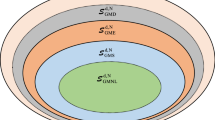Abstract
In a recent article, Cetto et al. (Found Phys 50:27–39, 2020) present an elegant formalism analyzing the probabilistic properties of the quantum singlet state correlations. From their study, they conclude the quantum formalism entails a partitioning of the probability space which is supposed to be absent in Bell’s hidden variables probabilistic model. We formally prove that this is not the case and that Bell’s probabilistic model does indeed possesses the characteristic that is supposed to be missing. Therefore, contrary to their claim, their observation does not put into question the applicability of Bell-type inequalities to the bipartite singlet state.
Similar content being viewed by others
Notes
We do not include \(\alpha _i,\beta _j\) as explicit arguments in \(\mathbf {\Lambda }_k({\mathbf {a}},{\mathbf {b}})\) because according to (7) the index k already determines them.
The expression \(A_k=\alpha _i\beta _j\) should not be considered a functional factorization since \(\alpha _i\) and \(\beta _j\) represent constants used to classify the different eigenvalues according to the enumeration scheme (7).
CL is known in the literature with different names: no-conspiracy, freedom, measurement independence, or statistical independence.
References
Cetto, A.M., Valdés-Hernández, A., de la Peña, L.: On the spin projection operator and the probabilistic meaning of the bipartite correlation function. Found. Phys. 50, 27–39 (2020)
Oaknin, D.H.: The Bell theorem revisited: geometric phases in gauge theories. Front. Phys. 8, 142 (2020)
Feldmann, M.: New loophole for the Einstein–Podolsky–Rosen paradox. Found. Phys. Lett. 8(1), 41–53 (1995)
Lambare, J.P.: On the CHSH form of Bell’s inequalities. Found. Phys. 47, 321–326 (2017)
Lambare, J.P.: Comment on “A loophole of all “loophole-free” Bell-type theorems”. Found Sci 26(4), 917–924 (2021)
Lambare, J.P.: Bell inequalities, counterfactual definiteness and falsifiability. Int. J. Quantum Inf. 19(03), 2150018 (2021)
Lambare, J.P., Franco, R.: A note on Bell’s theorem logical consistency. Found. Phys. 51(84) (2021)
Nieuwenhuizen, T.M.: Is the contextuality loophole fatal for the derivation of Bell inequalities? Found. Phys. 41, 580–591 (2011)
David Mermin, N.: Hidden variables and the two theorems of John Bell. Rev. Mod. Phys. 65, 803–815 (1993)
Shimony, A.: Contextual hidden variables theories and Bell’s inequalities. Br. J. Philos. Sci. 35, 25–45 (1984)
Muchowski, E.: On a contextual model refuting Bell’s theorem. EPL (Europhys. Lett.) 134(1), 10004 (2021)
Lambare, J.P.: Comment on “On a contextual model refuting Bell’s theorem” by Muchowski Eugen. EPL (Europhys. Lett.) 134(5), 50001 (2021)
Bell, J.S.: On the Einstein-Podolsky-Rosen paradox. Physics 1, 195–200 (1964)
Bell, J.S., Shimony, A., Horne, M.A., Clauser, J.F.: An exchange on local beables. Dialectica 39(2), 85–110 (1985)
Bell, J.S.: Free variables and local causality. Epistemol. Lett. (1977)
Bell, J.S.: Speakable and Unspeakable in Quantum Mechanics, Chapter Introduction to the Hidden Variable Question, pp. 36–37. Cambridge University Press, Cambridge (2004)
Lambare, J.P.: On Nieuwenhuizen’s treatment of contextuality in Bell’s theorem. Found. Phys. 47, 1591–1596 (2017)
Werner, R.F.: Comment on “What Bell did.” J. Phys. A 47, 424011 (2014)
Maudlin, T.: Reply to comment on What Bell did. J. Phys. A 47, 424012 (2014)
Boughn, S.: Making sense of Bell’s theorem and quantum nonlocality. Found. Phys. 47, 640–657 (2017)
Laudisa, F.: Stop making sense of Bell’s theorem and nonlocality? Eur. J. Philos. Sci. 8, 293–306 (2018)
Griffiths, R.: Nonlocality claims are inconsistent with Hilbert-space quantum mechanics. Phys. Rev. A 101, 022117 (2020)
Lambare, J.P.: Comment on “Nonlocality claims are inconsistent with Hilbert-space quantum mechanics.” Phys. Rev. A 104, 066201 (2021)
Griffiths, R.B.: Reply to “Comment on ‘Nonlocality claims are inconsistent with Hilbert-space quantum mechanics”’. Phys. Rev. A 104, 066202 (2021)
Author information
Authors and Affiliations
Ethics declarations
Conflict of interest
The author declares that he has no conflicts of interest.
Additional information
Publisher's Note
Springer Nature remains neutral with regard to jurisdictional claims in published maps and institutional affiliations.
Rights and permissions
About this article
Cite this article
Lambare, J.P. On the relevance of Bell’s probabilistic model for spin correlations. Quantum Stud.: Math. Found. 9, 211–217 (2022). https://doi.org/10.1007/s40509-021-00265-7
Received:
Accepted:
Published:
Issue Date:
DOI: https://doi.org/10.1007/s40509-021-00265-7




